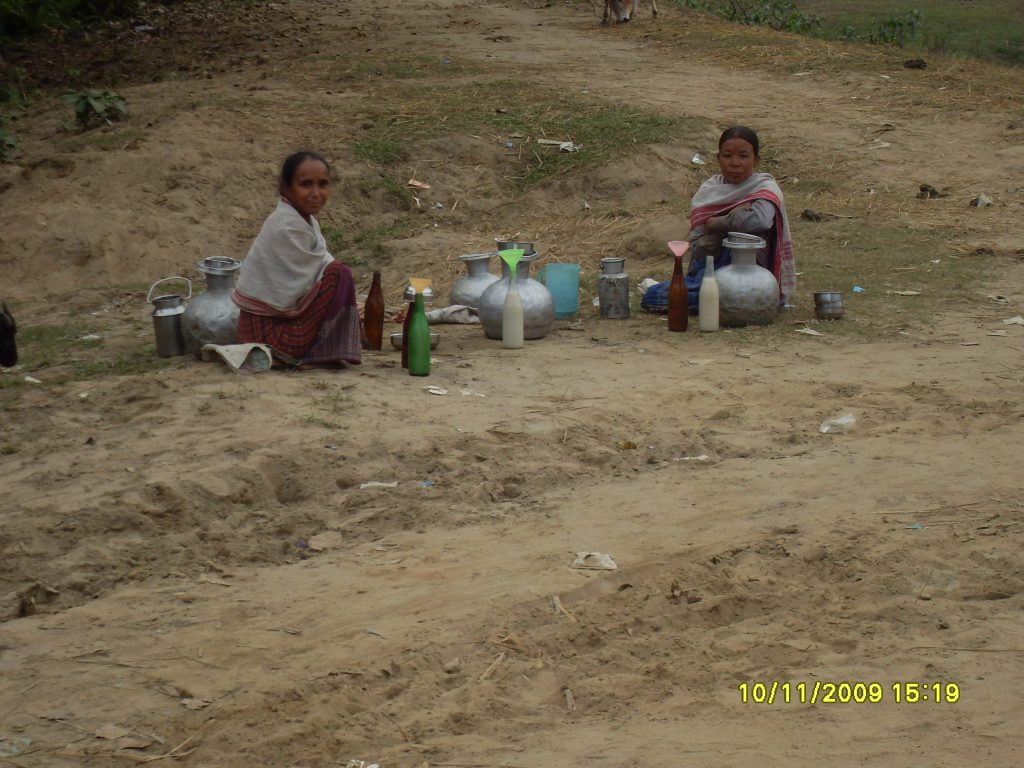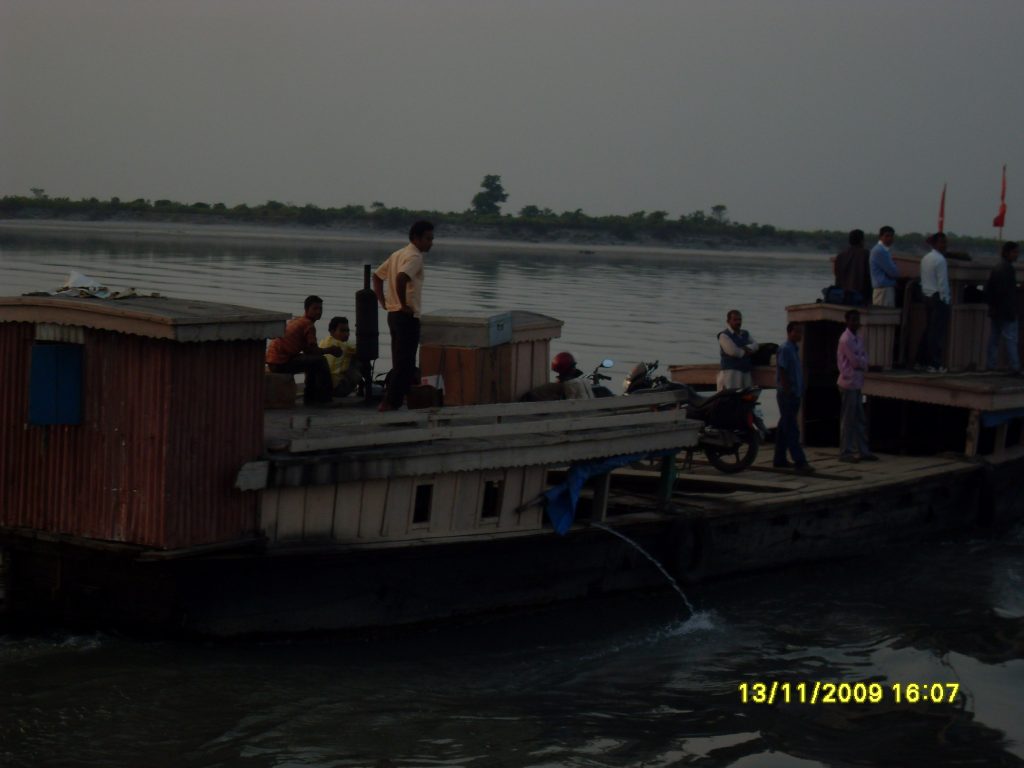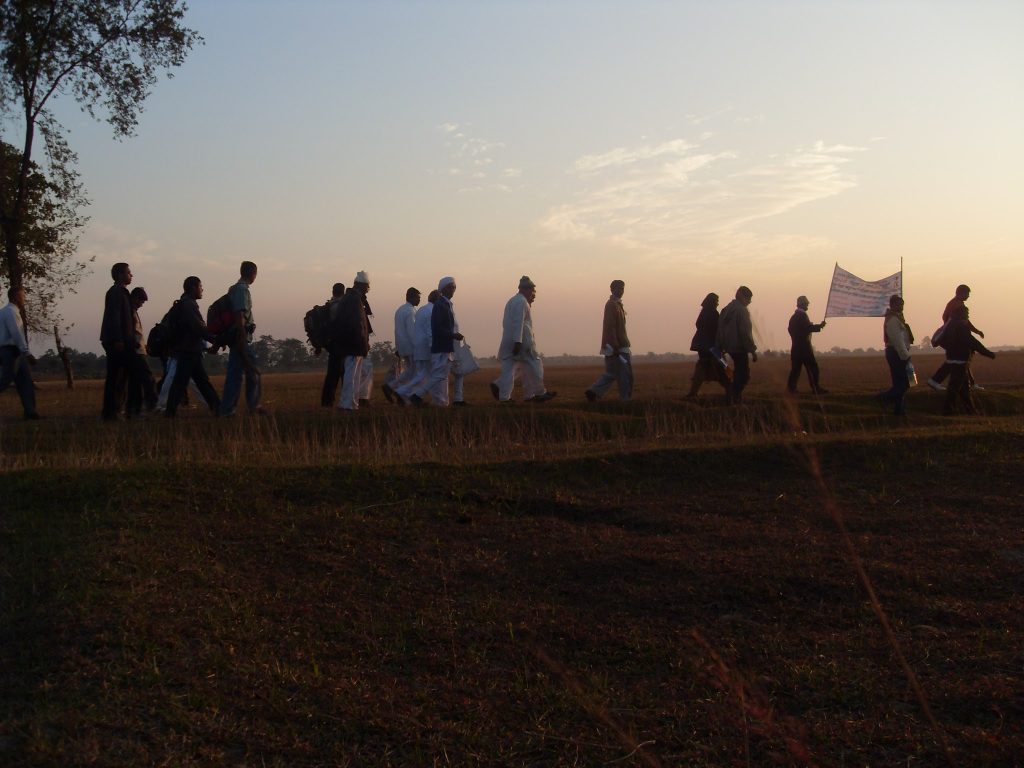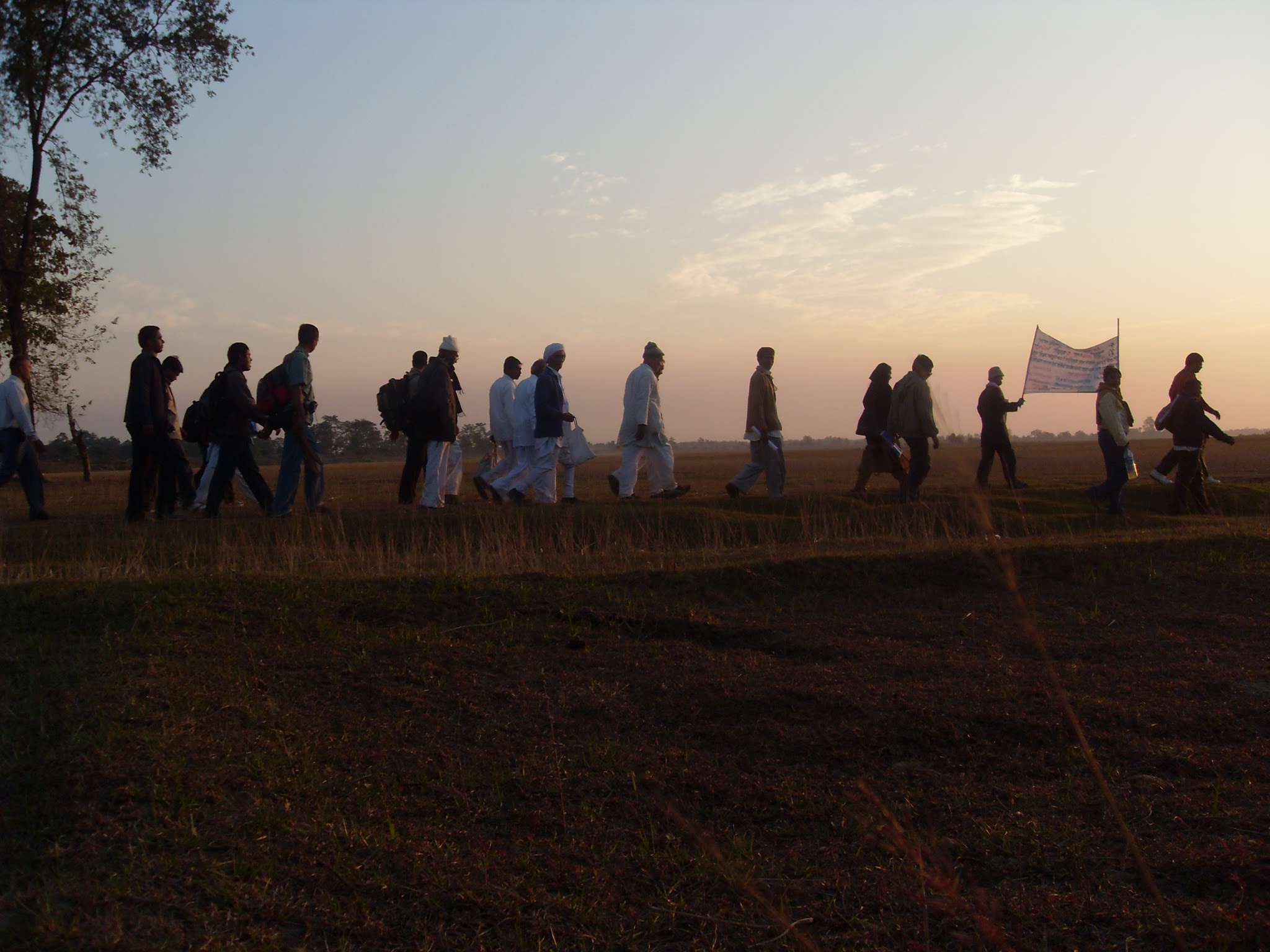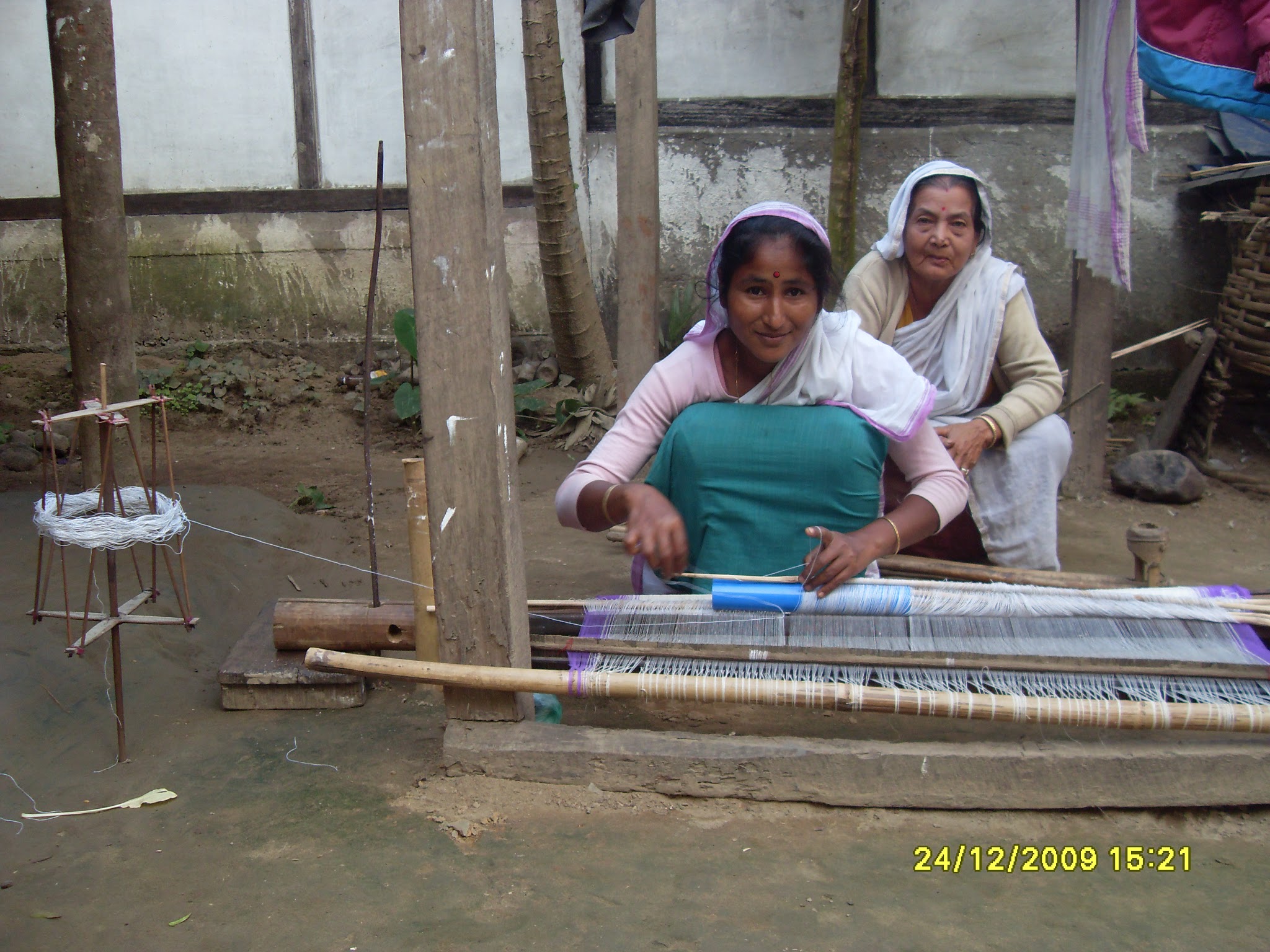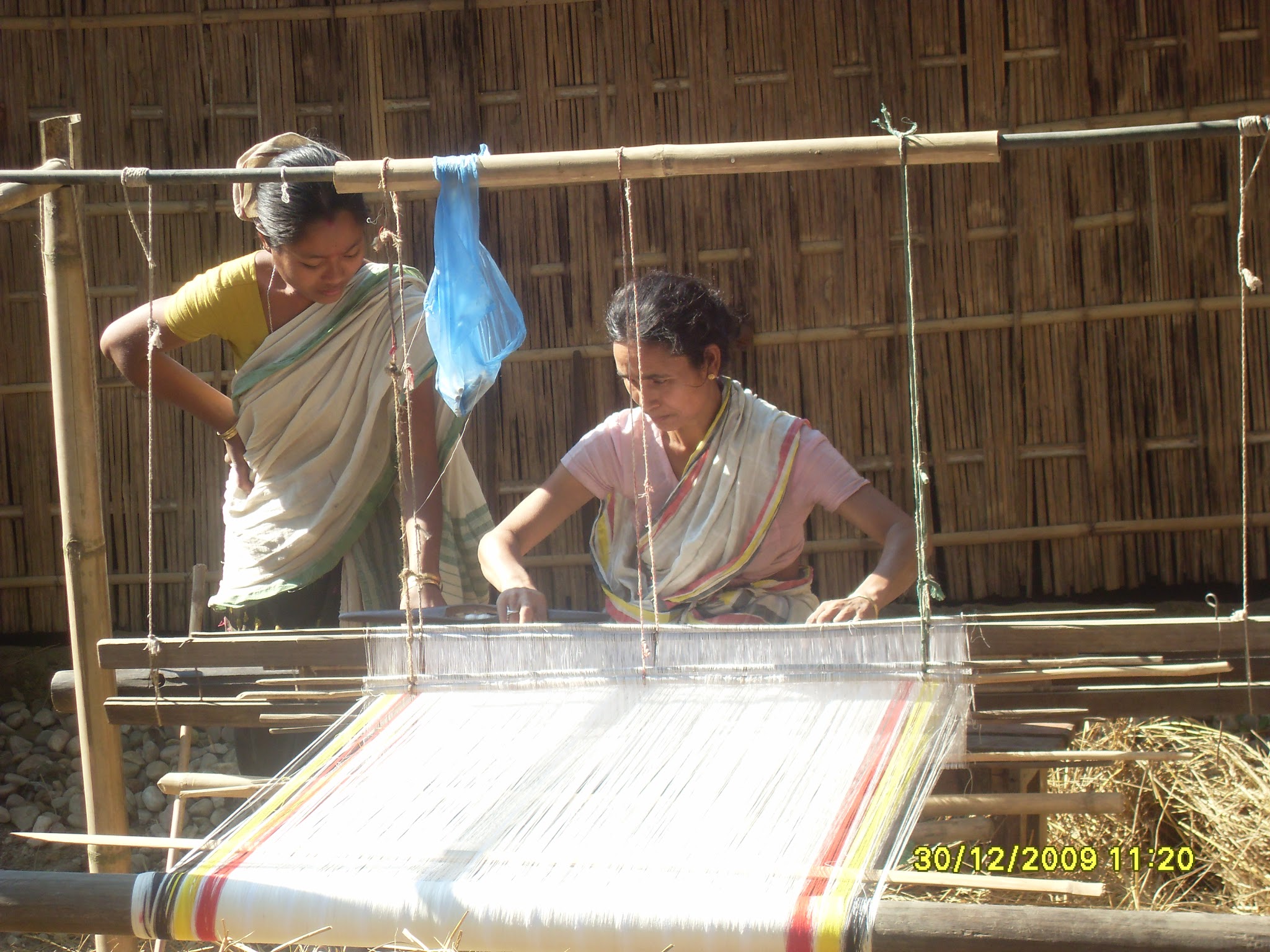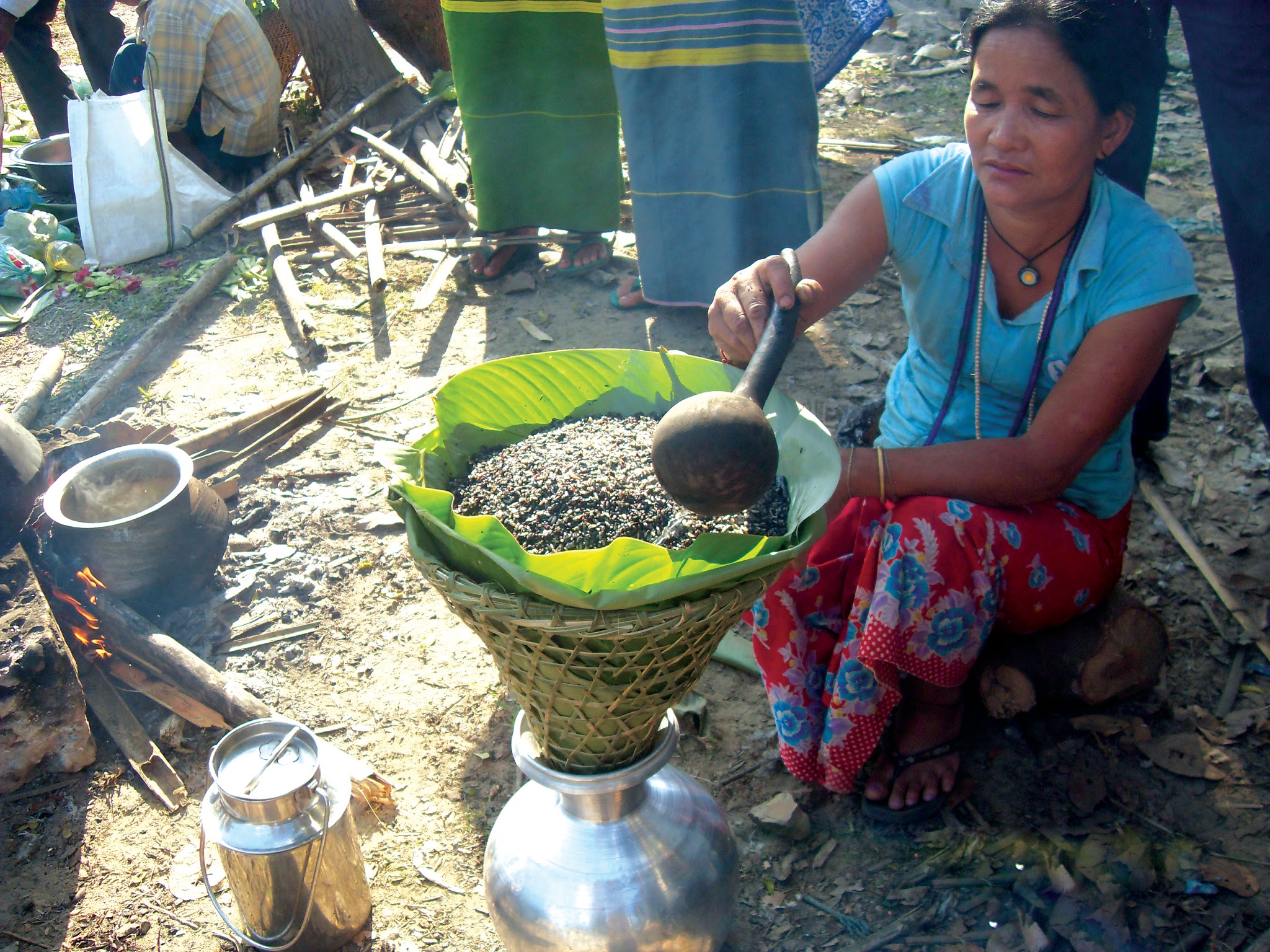Get Next Shodhyatra Update:
Phone:
079-27913293, 27912792
Email:
shodhyatra@sristi.org
24TH SHODHYATRA - OKAJAN TO HATHIGADH (ASSAM)
Brahmaputra: Binding Lands and Lives
Thinking about Assam, a cornucopia of lush greenery, small rivulets, mountain streams, lakes, paddy fields, Bihu and the mighty Brahmaputra conjures our mind. While crossing one of the tributaries of Brahmaputra on a ferry, the Shodhyatris, eighty in number, from different states of India and many foreign countries, were trying to get an eyeful of the great river and concomitantly trying to match mental images to the sight in front. Some of them were discussing their initial impressions with their new-found friends while the others were sharing their experiences of previous Shodhyatras. Overall, the ambience was reflective. Intently looking at the flowing river; an attentive look at their faces clearly showed that while the river waves were stroking the ferry, its splashes were producing undercurrents in the minds, quite emphatically.
To say that the river Brahmaputra binds the lands as well as the lives in Assam would be both, a metaphor as well as a comment on reality. The rich silt that the river brings with each flood is vital to agriculture, also the huge heap of sand that gets deposited in the agricultural fields agonizes the farmers. This river forms the lifeline of Assam when it comes to water for irrigation, river based transportation and not to forget its intricate linkages with the livelihoods of people in Assam.
After a brief travel on the ferry the Shodhyatris reached “Akajan”, a village on the river bank. People, especially students, small children and their parents, had assembled in the school premises and welcomed Shodhyatris with the traditional Arecanut offering, locally known as ‘Guwa’ or ‘Tamol’. We were welcomed by this offering many times during the six days of the Shodhyatra.
In Assamese culture, Tamulpan (the areca nut and betel leaves) or guapan (gua from kwa) are considered as the offers of devotion, respect and friendship. This ancient tradition is being followed since time-immemorial with roots in the aboriginal Austro-Asiatic culture.
It was mentioned that like the churning of milk gives ghee, the knowledge of local people may be put in a database specific to Assam. This knowledge could help leverage abundant local resources in creating value products and may boost the village economy. This may also preserve traditional knowledge of the villages for use by the future generations. The curiosity of students suggested that they were willing to engage with the Shodhyatris in the journey. But it was not sure whether local administration and entrepreneurs would take these leads forward.
On the first night, the Shodhyatris discussed many issues like decentralized, polycentric, and entrepreneurial process of development related to Arecanut, organic farming of numerous herbs and handloom designs. An interesting Zen story was told at the end of the meeting. Idea was that to learn one has to be like an empty glass i.e. in order to learn one needs to unlearn first and then proceed with an open mind.
The reception at Akajan Tribal Girls’ School made Shodh Yatris feel highly enthused about possible impact. On the way, the cleanliness and orderliness in the households and their surroundings impressed everybody.
“Jal, jungle, jameen, aur jaankaari”
After reaching Harupam Hajong village, Mr. Prasanna Vohra, who was the District Secretary of “Krishak Mukti Sangram Samiti”, sang a song about his organization’s struggle for “Jal, jungle aur jameen” i.e. water, forest and land rights of the tribal communities in the Dhemaji district of Assam. It was then added by Shodhyatris that similar to the struggle for “Jal, jungle and jameen”, the Honey Bee Network is waging a war for “Jaankaari” i.e. knowledge rights of the people. Mushtaq Hussain and Krishnakant, grassroots innovators awarded for their innovations, talked to the villagers about their innovations and also about the work being done by organizations like NIF, and SRISTI towards this cause.
Towards the end of the meeting, Rai Saab, who had joined the “Krishak Mukti Sangram Samiti” as a volunteer recently, addressed the Shodhyatris. He went on to describe the two major problems of the tribal communities inhabiting the area; pressure from the Forest Department and the Army. He said, “There are chances of escape from the Forest department but to escape from the Army personnel is very difficult. Its effect on livelihood of the tribals was very crucial. Most tribals had to migrate as daily wage labourer in the nearby towns and settlements. The villages were named by the name of tribes residing in the village. The Hajong village was named after the Hajong tribe that was the majority tribe in the village.
Looms: Binding threads and relationships
After lunch at Harupam Hajong village, Shodhyatris headed towards Borpathar Bohain village. On the way we met a girl named Jyotismita Dolai who was weaving a very beautiful shawl on a hand-operated loom. When asked, how she remembers the designs that she has to depict on the shawl, she said, it’s all in her mind. It takes around one week to weave a shawl or “Mekhla”, and its price is often determined by the design woven on it. An interesting fact emerged during this dialogue that when a boy has to propose to a girl, he simply appreciates her work and then her response determines what happens next!
Moving ahead, the Shodhyatris came across an old lady named Phulmani Bhakta and her daughter. The remarkable thing about the old lady was that she used to answer every question with a song. When asked, did she forget things due to her age; she gave an answer through a folk song. Similarly, on being asked, did she share her traditional knowledge with her children and grand children; she smiled and again sang a song. As a mark of respect for the elderly, we honoured her and sought her blessings. She was very happy, particularly after seeing her photograph taken earlier and presented to her during the Shodh yatra.
A lot to learn
By the time Shodhyatris reached Nilakh, a village on the border of Assam and Arunachal Pradesh, it was already dark. The meeting was held in a school. It was more like a community quiz wherein photographs and videos of around 70-80 plants were shown and the people assembled there were asked to identify them. When correctly identified, they were asked to comment on its properties. The response was not up to the mark but the purpose of knowledge sharing was served.
The best part was the collaborative nature of the effort being put by the assembly; especially the young people who seemed to be enjoying it all. At night, a discussion was held wherein Smt. Manta Kumari mentioned the use of a particular plant, locally called as “Leefafu”, for treating high blood pressure.
During the meeting, one of the Shodhyatris, Chris, from Ireland, said, “Being a professional designer, i used to think that i could teach a lot to people when it comes to design. But given my experience in the Shodhyatra, i am sure, i need to learn a lot from the ingenuity of common people.” An instant reaction to Chris’ remark came from Gagan. He said, “Now, I also realize the import of knowledge sharing.”
Water: All around but not to come by easily
Almost everywhere households had devised means of filtering iron-rich water for drinking purpose. Sand, pebbles and finally a cotton cloth is layered into a tin container. The filtered water dripping from the tin was collected in another bucket kept below the tin. It appeared to be a good solution but after a while Shodhyatris realized that it was not optimal.
The apparently clear water filled in the bottles turned yellow in a short while suggesting the sub-optimality of the solution.
The samples taken from some of these filtration units have been given to CSMCRI, Bhavanagar, a leading CSIR lab for testing the effectiveness of these filters.
Creativity amidst adversity: Raised hand pumps and toilets
In the meeting at Nilakh, Mr. Ravindra Nath (Director and founder of RVC, the host organization) shared his insights gathered over two decades of work in this region. Mr. Ravindra Nath had come to this region as part of a team doing water survey during the year 1989. The plight of people in this region affected him thoroughly and he decided to stay back and work for them. Presently, RVC works in the three districts of Assam including Dhemaji, Dibrugarh and Lakhimpur with a team of 6000 volunteers. He mentioned about the three major problems caused by floods. First, the massive erosion of land by rivers as a result of which a sizeable portion of the land is lost every year. It was jocularly quipped that due to this cutting/erosion of land in Assam a new island is being formed near Bangladesh in the sea called as New Moore’s Island. The second problem being water logging, which in some areas lasts as long as six months hampers sanitation, livelihood, mobility etc. The third problem was sand casting which means the deposition of sand on land particularly agricultural fields which renders the land uncultivable.
During the rainy season i.e. the months of May, June, July and August, RVC is under immense pressure to fulfill the two primary objectives of saving lives of humans and the livestock and then their proper rehabilitation in places at slightly higher altitude. In two decades, around ten thousand families have been rehabilitated in around 100 new villages. Mr. Ravindra Nath also mentioned about the two innovations that they had to develop to save people’s lives: the raised hand pumps and elevated toilets. He said, “Both these innovations have been extremely beneficial as they ensure two important aspects i.e. drinking water and sanitation during floods.” Ravindra Nath concluded by sharing an impending problem of the construction of around 168 dams in the mountain areas located in the region. These dams once completed, he believed , were bound to wreck havoc. A school teacher named Kanak Rai was felicitated for his knowledge of medicinal plants of the region. When the Shodhyatris were about to leave for Misamari, a young boy sitting in the audience got up and said that this Shodhyatra is one of the most memorable moments in the recent past of Kanki village. He wished good luck to all the Shodhyatris and pledged his support for the mission ahead.
Fishing: Innovative methods
Shodhyatris came across an innovative method of fishing with the help of a plant locally known as ‘medaluva’. This plant makes the fishes go numb and catching them becomes easy.
Using this plant along with a fish net made of Bamboo cane is quite common in this region.
Diversity & creativity in a local space
The village of Misamari had its own store of surprises for the Shodhyatris. First, a wood lathe machine that had a big wheel attached to it with pulley. Toka Borah demonstrated the working of the hand-driven machine in front of the Shodhyatris and in a matter of minutes he carved out a beautiful design in an amorphous piece of wood. The second surprise was again a wood cutting machine designed by Prafulla Borah which was driven by a cycle pedal mounted on a platform. Later in the walk, another variant of wooden lathe (driven by both legs) designed by Gulab Gogoi was seen at Misamari.These user driven innovations in such a close proximity were definitely evidences of the creativity of the people of the region.
In the meeting at Misamari, Anusuiya Gogoi shared her traditional knowledge about medicinal plants of the region, running in her family for generations. The knowledge had thrived for three generations in a functional and vibrant manner. This was a special case and hence Anusuiya Gogoi and her mother were felicitated for their contribution to the preservation of traditional knowledge. On the way, Shodhyatris came across another hand operated loom. During the conversation with the lady, the sad plight of the hand loom operators came to the fore. She said, “We are like labourers because the input material is given by the contractor and also the marketing of the final product is done by him. Our margins are very low as the bulk of the profit is pocketed by the contractors. Are not we just the labourers.”
Carving life in the dead wood: Learning early to excel
At Raiting, a twelve year old boy named Harikanta Gogoi who had made beautiful statues of Gods’ and Goddesses’ was recognized for his wonderful skill. Also, in the meeting at night, one young member of the audience gave some amazing ideas. Force of gravitation to power engines, no matter how feasible it was, the point was that the youth in the village had dreams. This meant that they were not satisfied with the present state of affairs and desired to change it, in this case through science.
In the recipe competition held next day in the morning, Falguni Gogoi had prepared eight different chutneys using different locally available herbs. She even knew the medicinal properties of all of them. Later in the meeting, Falguni and a centenarian couple were felicitated. The couple attributed natural food and natural treatment as the two main causes behind their longevity. In a light banter, the husband, when asked about the age of his wife, said that she was more than 100 years old. This made all the assembled people burst into laughter. Adding to it was the wife’s reaction; she blushed and this added to the enjoyment of the people around.
Work on display but not to be seen: Tryst with NREGS
The path to Da Subahi had many streams, which did not have bridges. There were of course many boards with details of the work under NREGS depicted on them. But much of that work was missing. While crossing one of the streams, the jeep got stuck in the sand. It was getting dark as well. Initially, the people sitting in the jeep tried their best to pull it out but to no avail. Later, more shodhyatris joined the rescue team and eventually freed the jeep from its sandy trap.
Lalit Dowara recalled the special relation that the Honey bee Network shared with their village. Mushtaq Ahmed, the innovator of bamboo wind mill, later appealed to the shodhyatris and the villagers to assist in the preservation of traditional knowledge and innovative spirit.
Creativity all the way
While walking out of this village, shodh yatris came across a foot pedal powered wooden lathe made by Gulab Gogoi. He had been using it for last seven years for wood carving. Although this lathe already seemed more efficient than the ones we had seen earlier, Gogoi wanted to increase its efficiency further by using a motor, powered by solar energy.
When asked if he would be able to design the assembly, he said that he already had a plan in mind and was waiting for some funding to take care of the initial cost.
A brief detour to Aru]nachal Pradesh: Learning Chinese in Nepali
When the shodh yatris reached Kanko Basti, a village in Arunachal Pradesh, a distinct cultural transition was noted not only in the design of houses, attire and the sacred signs, but also in the level of prosperity. Kanko basti seemed to have better economic conditions, though the complaints about national resources not reaching the grassroots was more pronounced here. An old man, presumably in his sixties and dressed in the traditional attire, came to meet us and shared with us the history of his village. He said that about 300 years ago, their ancestors had migrated from areas situated at higher altitudes of Arunachal Pradesh to this village. The reason for migration was the increase of pressure on the natural resources on which they depended most. He explained, “Jameen nahin badhti aur aadmi badhte chale gaye isliye humaare purkhon ko pahaadon se niche aana pada. Hum log jungle par hi nirbhar karte hain apni roz ki jarooraton ke liye.” Local communities practiced “Jhoom” or shifting cultivation cycle for six to eight months in a year. They returnto the same patch of land after around twelve years. They also grow a different variety of paddy in the Jhoom method of cultivation.
The lack of sensitivity to the strategic role of language and presence of national programs became apparent when villagers mentioned about a radio programme in which the Chinese broadcasters were running a tutorial on the basics of Chinese language in Nepali. While all these discussions were going on, most of the shodh yatris were waiting for a delicacy that was being prepared by the villagers for our lunch. Bamboo rice is a special preparation in Arunachal Pradesh. It is prepared by cooking rice inside Bamboo shoots. Everybody savoured this rice and some also partook in the rice brew that was freshly being filtered. After a brief but memorable detour to Arunachal, the shodh yatris started walking towards Paanchali village. The villagers gifted us with an old bow, vest and a hat as souvenirs. Several homes here had local icons outside in the gardens signifying local spiritual beliefs. Different faiths intermingled here without any problems. Many local community members wanted to convey their strong dissatisfaction with the way public programs were implemented. They wanted their grievances to be conveyed to higher level policy makers.
Knowledge for public good: Any takers?
At Jaamugiri High school in Panchaali village, many herbal healers had come to interact with the shodh yatris. Prominent among them was a young herbal healer named Sitaram Haldhar who had been practicing this art for the last five years. When asked if he felt that by sharing his knowledge he would be at loss, he said, “My ultimate goal is the well being of my patients. Knowledge sharing would in fact be good as more and more people would know about useful herbs and thus more patients would benefit.” He also mentioned about his maternal uncle from whom he had learnt a lot. The next morning we felicitated his uncle. Later in the meeting, a lady herbal healer shared her knowledge with us. She had been treating humans as well as animals using medicinal plants found in the region. She said that she had treated human patients with diseases like pneumonia and many gynaecological problems besides treating different diseases in the livestock.
In the evening during a brainstorming session, someone suggested that threshing in this region is mostly done with the help of cattle and is quite inefficient. Better mechanised or machine based alternatives need to be developed. Pedal driven thresher found in Purulia could be tried out here. A question that bothered all shodh yatris was, ‘When the news about film, music, and politics gets disseminated widely, why should such innovations remain localised?’. Others were worried about the increasing use of plastic based products rather than bamboo products.
Meeting at the God's place
At Jaamugiri, the meeting was held inside a temple. This was out of the ordinary; meeting in a sacred place just showed the respect that they had for strangers like us. Everybody agreed that the knowledge should be shared widely.
At Jaamugiri, the meeting was held inside a temple. This was out of the ordinary; meeting in a sacred place just showed the respect that they had for strangers like us. Everybody agreed that the knowledge should be shared widely.
During the meeting a young boy named Krishna Bora came forward and showed an innovative candle that he had designed for participation in a national level Science Congress for children. His work was applauded by one and all.
During the meeting a young boy named Krishna Bora came forward and showed an innovative candle that he had designed for participation in a national level Science Congress for children. His work was applauded by one and all.
Kids’ rock! Indeed
The second last day was quite eventful because relatively more number of villages had to be covered. A large assembly of young school kids had gathered in the school compound in Bishnupur Tekjuri to welcome the shodh yatris. The kids, dressed in dhotis and saris, looked lovely when they performed Bihu. The centre of attraction was a young kid who was playing “Mridang”. Although he was unable to hold the heavy “Mridang”, he was still performing to the best of his ability.
In the ensuing meeting also the school kids stole the show by showcasing their creativity and innovative spirit. Plaban Baruah & Saurav Baruah, students from Madhyamik Vidyalaya, presented their project on ‘control of plant weed Mikania by useful means.’ They had earlier presented this project in a national level Science Congress for children. Apart from the merit of the project, the confidence of the duo impressed the shodh yatris a lot.
City boys versus village girls
At Tekjuri, a competition was organized between village girls and city boys to write down the names of plants they see daily. Both the parties wrote more than 175 names of the plants in 15 minutes but the village girls had more variety and less common plants and were announced the clear winners.
Later, both the groups were asked to work towards finding out the medicinal properties of the plants that they had identified during the competition.
Love breeds creativity
On the way to Giyadhal Amulgiri, Shodh yatris met Midul Salang. He had made a miniature working model of a JCB. When he did not have the money to buy a similar toy for his child, he thought of designing the same and did so to perfection.
The toy JCB was working fine. He had seen the machine only recently when it was used for a road construction in a nearby area. The pure affection of a father towards his son was quite evident.
The walk ends; journey has just begun
On the last day of the 24th shodh yatra we had the final meeting at village named Hatigarh – the last pit stop in our schedule. We met Deba Koch, a locally well known herbal healer. He also held a patent on his herbal formulation for Malaria. He was quite happy to share his experience with the shodh yatris. Another herbal healer we felicitated at Hatigarh was Vikram Badora.
Lest people forget that leadership of ULFA, an insurgent organization hailed from this region, it did not escape anyone’s notice that neglect was still the rule rather than the exception. Given the apathy of public policy makers and lack of economic development, should it surprise anyone that many young people become angry and choose violent ways which of course we don’t endorse. There is a crying need for more intensive social engagement in this region. Hopefully, somebody will listen before the noise becomes too loud to ignore any way.
FLICKR GALLERY
